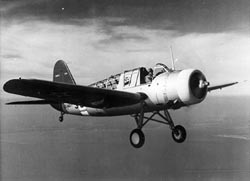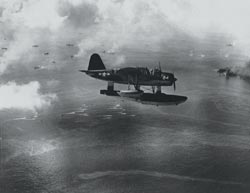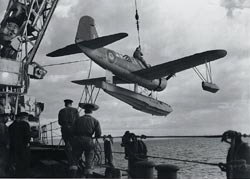|
 Behind the Kingfisher’s wartime achievements stands the story of the engineering accomplishments that made it all possible. In designing this aircraft, Vought engineers had to meet specified basic design requirements to produce an aircraft which would do a better observation-scouting job than had ever been done before. Among the goals sought were excellent vision (for tactical missions), limited size (for shipboard use), low landing speed (for rough water landings), excellent water handling (for serviceability), long endurance for special missions, and good all-around performance. That the job was well done is apparent from the Kingfisher’s versatile record – a record that earned it the title “Workhorse of the Fleet.” Behind the Kingfisher’s wartime achievements stands the story of the engineering accomplishments that made it all possible. In designing this aircraft, Vought engineers had to meet specified basic design requirements to produce an aircraft which would do a better observation-scouting job than had ever been done before. Among the goals sought were excellent vision (for tactical missions), limited size (for shipboard use), low landing speed (for rough water landings), excellent water handling (for serviceability), long endurance for special missions, and good all-around performance. That the job was well done is apparent from the Kingfisher’s versatile record – a record that earned it the title “Workhorse of the Fleet.”
Hundreds of these observation scout aircraft, the OS2U1’s, -2’s, and –3’s, were delivered to the Navy and established superlative records in convoy duty and rescue work.
 Although intended almost solely for gunnery-spotting and routine observation tasks, the Kingfisher was adapted to many other tasks. In the South Pacific, three Kingfishers teamed up to depth charge and destroy one of Japan’s largest submarines. Kingfishers were used to maintain constant vigilance in anti-submarine patrol along most of the North American coast, carrying enough bombs to do their own sinking of enemy undersea craft. Although intended almost solely for gunnery-spotting and routine observation tasks, the Kingfisher was adapted to many other tasks. In the South Pacific, three Kingfishers teamed up to depth charge and destroy one of Japan’s largest submarines. Kingfishers were used to maintain constant vigilance in anti-submarine patrol along most of the North American coast, carrying enough bombs to do their own sinking of enemy undersea craft.
Convertible to either landplane or seaplane, the Kingfishers were called upon for a great variety of missions. In the initial assault against the Japanese based on Attu in the Aleutians, they were rigged as dive bombers with conspicuous success. In this action, they carried 335-pound bombs instead of the lighter bombs for which they were designed. They came through in characteristic Vought style.
 The Kingfisher was designed specifically for catapult operation from battleships and cruisers. Previously, all aircraft used by the Navy for this type operation had been biplanes. The OS2U-1 was the first monoplane to be placed in catapult service. The ingenuity of Vought engineers, who had developed the special high-lift and control devices made this possible. The Kingfisher was designed specifically for catapult operation from battleships and cruisers. Previously, all aircraft used by the Navy for this type operation had been biplanes. The OS2U-1 was the first monoplane to be placed in catapult service. The ingenuity of Vought engineers, who had developed the special high-lift and control devices made this possible.
Based with the fleet, Kingfishers ranged far during World War II, seeing action in widely scattered war theaters. The British Fleet Air Arm received 100 OS2U-3’s with both float and wheel gear. Twenty-four OS2U-3’s were allocated to the Royal Netherlands Navy. The Naval Aircraft Factory built another 300 similar aircraft under the designation OS2N-1
More VE-7:
Engineering Triumph and War Hero
Fisher of Men
One Saves Ten Men
Tortoise Nips the Hare
|

 Behind the Kingfisher’s wartime achievements stands the story of the engineering accomplishments that made it all possible. In designing this aircraft, Vought engineers had to meet specified basic design requirements to produce an aircraft which would do a better observation-scouting job than had ever been done before. Among the goals sought were excellent vision (for tactical missions), limited size (for shipboard use), low landing speed (for rough water landings), excellent water handling (for serviceability), long endurance for special missions, and good all-around performance. That the job was well done is apparent from the Kingfisher’s versatile record – a record that earned it the title “Workhorse of the Fleet.”
Behind the Kingfisher’s wartime achievements stands the story of the engineering accomplishments that made it all possible. In designing this aircraft, Vought engineers had to meet specified basic design requirements to produce an aircraft which would do a better observation-scouting job than had ever been done before. Among the goals sought were excellent vision (for tactical missions), limited size (for shipboard use), low landing speed (for rough water landings), excellent water handling (for serviceability), long endurance for special missions, and good all-around performance. That the job was well done is apparent from the Kingfisher’s versatile record – a record that earned it the title “Workhorse of the Fleet.”
 Although intended almost solely for gunnery-spotting and routine observation tasks, the Kingfisher was adapted to many other tasks. In the South Pacific, three Kingfishers teamed up to depth charge and destroy one of Japan’s largest submarines. Kingfishers were used to maintain constant vigilance in anti-submarine patrol along most of the North American coast, carrying enough bombs to do their own sinking of enemy undersea craft.
Although intended almost solely for gunnery-spotting and routine observation tasks, the Kingfisher was adapted to many other tasks. In the South Pacific, three Kingfishers teamed up to depth charge and destroy one of Japan’s largest submarines. Kingfishers were used to maintain constant vigilance in anti-submarine patrol along most of the North American coast, carrying enough bombs to do their own sinking of enemy undersea craft.
 The Kingfisher was designed specifically for catapult operation from battleships and cruisers. Previously, all aircraft used by the Navy for this type operation had been biplanes. The OS2U-1 was the first monoplane to be placed in catapult service. The ingenuity of Vought engineers, who had developed the special high-lift and control devices made this possible.
The Kingfisher was designed specifically for catapult operation from battleships and cruisers. Previously, all aircraft used by the Navy for this type operation had been biplanes. The OS2U-1 was the first monoplane to be placed in catapult service. The ingenuity of Vought engineers, who had developed the special high-lift and control devices made this possible.